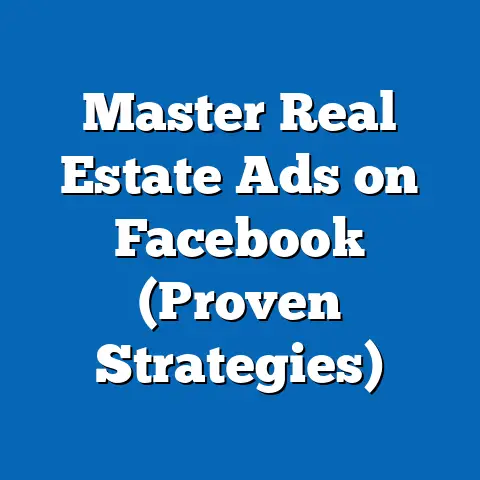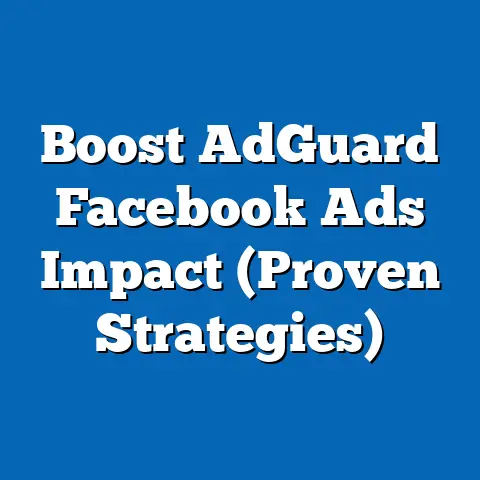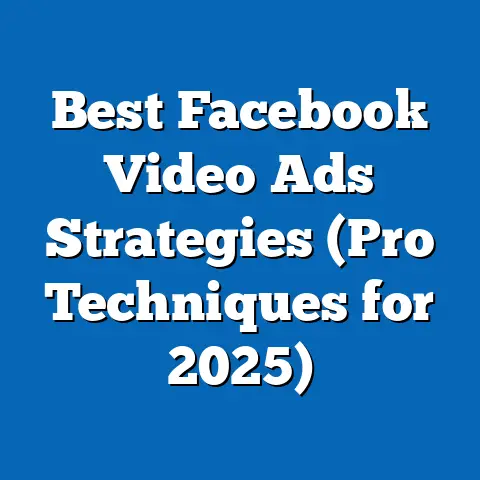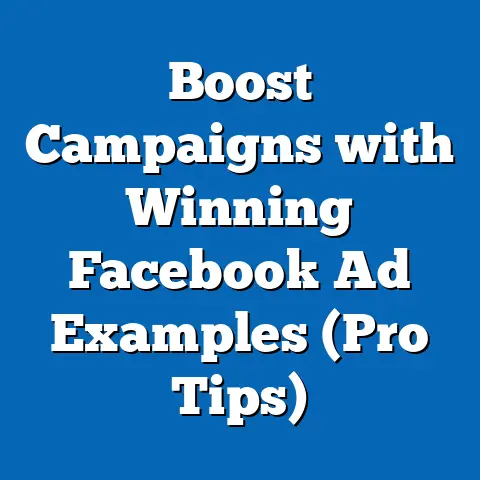Maximize Impact: Facebook Ad Copy Length Secrets (Insider Tips)
In today’s fast-paced digital world, grabbing someone’s attention, especially on a platform like Facebook, is like trying to catch lightning in a bottle. We’re constantly bombarded with information, making it crucial that our messages are not only eye-catching but also easily digestible. That’s where the length of your Facebook ad copy comes into play. It’s not just about what you say, but how you say it, and how much of it you say. The length of your Facebook ad copy can significantly affect its reach and effectiveness. Accessible messaging ensures that your advertisements resonate with a broader audience, including those with varying levels of literacy and comprehension.
Think about it: a long, convoluted ad might lose someone before they even get to the call to action. On the other hand, too short, and you might not convey enough information to pique their interest. According to recent statistics, a staggering 70% of social media users prefer engaging with content that is concise and to the point. This means that mastering the art of crafting the perfect ad copy length is no longer just a suggestion; it’s a necessity for success on Facebook.
In this guide, I’ll be sharing insider tips and secrets on how to optimize your Facebook ad copy length to maximize impact, improve engagement, and ultimately, drive conversions. I’ll cover everything from understanding Facebook’s ad copy guidelines to delving into the psychology behind consumer behavior and even exploring industry-specific best practices. So, buckle up, and let’s dive in!
Understanding Facebook Ad Copy Length
When we talk about Facebook ad copy length, we’re not just referring to the main body of text. It encompasses several key components:
- Primary Text: This is the main text that appears above or below your ad’s visual content (image or video). It’s your chance to grab attention and convey your core message.
- Headline: The headline is the bold text that appears below the visual content. It should be concise, attention-grabbing, and directly relevant to your offer.
- Description: This optional text appears below the headline and provides additional context or details. It’s useful for elaborating on your offer or highlighting key benefits.
Now, let’s talk about formats. Facebook offers various ad formats, including single image, video, carousel, and collection ads. Each format has its own set of recommended and maximum character limits for these components.
Here’s a quick breakdown:
- Primary Text: Facebook recommends keeping it under 125 characters for optimal engagement. While you can go longer, shorter is generally better.
- Headline: Aim for around 25-40 characters. This is prime real estate, so make every character count.
- Description: Keep it concise, usually under 30 characters, to highlight key benefits or a strong call-to-action.
Why are these limits important?
Facebook’s algorithm favors ads that provide a good user experience. This means that ads with concise, easy-to-read copy are more likely to be shown to a wider audience. Overly long or cluttered ads can be penalized, resulting in lower reach and higher costs.
My Experience:
I remember working on a campaign for a local restaurant. We initially wrote a lengthy primary text that detailed the restaurant’s history, menu highlights, and special offers. While the information was comprehensive, the ad performed poorly. After shortening the primary text to a simple, enticing message (“Craving delicious Italian? Get 20% off your first order!”), the engagement skyrocketed. This experience taught me the power of brevity in Facebook advertising.
Takeaway: Understand Facebook’s ad copy length guidelines and tailor your message to fit within the recommended limits. It’s not about saying everything; it’s about saying the right things.
The Psychology of Ad Copy Length
Ever wonder why some ads grab your attention instantly while others fade into the background? A lot of it has to do with psychology. When it comes to ad copy length, several psychological factors come into play:
- Cognitive Load: This refers to the amount of mental effort required to process information. Long, complex ad copy can increase cognitive load, making it harder for people to understand your message. Shorter, simpler copy, on the other hand, reduces cognitive load and makes it easier for people to engage.
- Attention Span: Let’s face it, our attention spans are shrinking. According to studies, the average human attention span is now shorter than that of a goldfish. This means you have mere seconds to capture someone’s attention and deliver your message.
- Decision Fatigue: When we’re presented with too many choices or too much information, we experience decision fatigue. This can lead to inaction or impulsive decisions. By keeping your ad copy concise and focused, you reduce decision fatigue and make it easier for people to take the desired action.
The Long vs. Short Debate:
While shorter copy is generally preferred, there are exceptions. For products or services that require more explanation or have a higher price point, longer copy can be more effective. The key is to strike a balance between providing enough information and avoiding cognitive overload.
How to Match Length to Audience and Objectives:
- Know Your Audience: Understand their needs, interests, and pain points. Tailor your ad copy length to their preferences.
- Define Your Objectives: What do you want people to do after seeing your ad? If it’s a simple action like visiting a website, shorter copy is usually sufficient. If it’s a more complex action like signing up for a subscription, longer copy might be necessary to explain the benefits.
Example:
Imagine you’re advertising a new line of organic skincare products. For a general awareness campaign, a short, attention-grabbing headline like “Discover Radiant Skin, Naturally” might be enough. However, for a retargeting campaign aimed at people who have already visited your website, a longer description highlighting the specific benefits of your products (e.g., “Reduce wrinkles, hydrate dry skin, and protect against sun damage with our organic skincare line”) could be more effective.
Takeaway: Understand the psychological factors that influence consumer behavior and tailor your ad copy length accordingly. Consider your audience, objectives, and the complexity of your offer when deciding how much to say.
Crafting Concise and Impactful Messages
Okay, so we know that shorter ad copy is often better, but how do you actually write concise messages that still pack a punch? Here are some insider tips:
- Use Active Voice: Active voice makes your writing more direct and engaging. Instead of saying “The product was used by many customers,” say “Many customers use the product.”
- Choose Strong Verbs: Strong verbs convey action and excitement. Instead of saying “This product is good,” say “This product transforms your skin.”
- Eliminate Fluff: Cut out unnecessary words and phrases. For example, instead of saying “Due to the fact that,” simply say “Because.”
- Focus on Benefits: Highlight the benefits of your product or service, not just the features. Instead of saying “This camera has 20 megapixels,” say “Capture stunning, high-resolution photos with this camera.”
- Use Numbers and Statistics: Numbers and statistics add credibility to your message. For example, “Join 10,000+ satisfied customers” or “Boost your sales by 30%.”
- Create Urgency: Use words and phrases that create a sense of urgency, such as “Limited time offer,” “Sale ends soon,” or “Don’t miss out.”
- Have a Clear Call to Action (CTA): Tell people exactly what you want them to do. Use action-oriented CTAs like “Shop Now,” “Learn More,” “Sign Up,” or “Get Started.”
Examples of Compelling Short Ad Copy:
- Headline: “Free Shipping on Orders Over $50”
- Primary Text: “Shop our latest collection of summer styles!”
- Headline: “Get 20% Off Your First Order”
- Primary Text: “Use code WELCOME at checkout.”
- Headline: “Transform Your Body in 30 Days”
- Primary Text: “Join our fitness challenge today!”
- Primary Text: “Shop our latest collection of summer styles!”
- Primary Text: “Use code WELCOME at checkout.”
- Primary Text: “Join our fitness challenge today!”
My Editing Process:
When I’m crafting ad copy, I always start by writing everything I want to say, without worrying about length. Then, I go back and ruthlessly edit, cutting out any words or phrases that aren’t absolutely essential. I also ask myself, “What’s the single most important thing I want people to remember from this ad?” and make sure that message is crystal clear.
Takeaway: Crafting concise and impactful messages is an art. Use active voice, strong verbs, and persuasive language. Focus on benefits, create urgency, and include a clear call to action. Edit ruthlessly to eliminate fluff and ensure your message is crystal clear.
A/B Testing for Optimal Length
No matter how much research you do or how many best practices you follow, the only way to truly determine the best ad copy length for your specific audience and offer is through A/B testing.
What is A/B Testing?
A/B testing, also known as split testing, is a method of comparing two versions of an ad (A and B) to see which one performs better. In the context of ad copy length, you would create two versions of your ad with different primary text, headline, or description lengths and see which one generates more engagement, clicks, or conversions.
How to Set Up A/B Tests on Facebook:
- Create a Campaign: Start by creating a new Facebook ad campaign or editing an existing one.
- Choose Your Objective: Select the objective that aligns with your goals (e.g., traffic, conversions, lead generation).
- Create Ad Sets: Divide your audience into two or more ad sets.
- Create Ad Variations: Within each ad set, create two or more ad variations with different ad copy lengths.
- Set Your Budget and Schedule: Allocate your budget evenly across the ad sets and schedule your test to run for a sufficient period of time (at least a week) to gather meaningful data.
- Monitor Performance Metrics: Track key metrics such as reach, impressions, click-through rate (CTR), conversion rate, and cost per acquisition (CPA).
- Analyze Results: After the test has run for a sufficient period, analyze the results to determine which ad variation performed better.
Common Outcomes and Insights:
- Shorter Copy Wins: In many cases, shorter ad copy will generate higher CTRs and lower CPAs. This is because people are more likely to engage with concise messages that are easy to understand.
- Longer Copy Wins: In some cases, longer ad copy may generate higher conversion rates. This is because it provides more information and can help overcome objections or concerns.
- No Significant Difference: Sometimes, there will be no significant difference between the performance of different ad copy lengths. This could indicate that other factors, such as the visual content or targeting, are more important.
My A/B Testing Mishap:
I once ran an A/B test where I assumed that a longer, more detailed ad copy would always outperform a shorter one for a complex tech product. To my surprise, the concise version, highlighting only the top three features, not only had a higher click-through rate but also led to more qualified leads. This taught me to never underestimate the power of simplicity and to always let the data guide my decisions.
Takeaway: A/B testing is essential for determining the best ad copy length for your specific audience and offer. Set up tests, monitor performance metrics, and analyze results to gain valuable insights. Don’t be afraid to experiment and challenge your assumptions.
Ad Copy Length in Different Industries
While the general principles of ad copy length apply across industries, there are some nuances to consider. The ideal ad copy length can vary depending on the industry, target audience, and the nature of the product or service being offered.
E-Commerce:
In e-commerce, shorter ad copy is often preferred. Focus on highlighting key product features, benefits, and special offers. Use strong visuals and a clear call to action.
- Example: “New Arrivals! Shop our latest collection of summer dresses. Free shipping on orders over $50.”
Real Estate:
Real estate ads often require more detailed information, such as property features, location, and price. However, it’s still important to keep the ad copy concise and focused. Use bullet points or short paragraphs to break up the text and make it easier to read.
- Example: “Luxury Condo for Sale! 2 bedrooms, 2 bathrooms, stunning city views. $750,000. Call now for a private tour.”
Services:
For service-based businesses, focus on highlighting the benefits of your services and building trust with potential customers. Use testimonials or case studies to add credibility.
- Example: “Get a Free Consultation! Our expert team can help you achieve your financial goals. Call today to schedule your appointment.”
Industry-Specific Insights:
- Fashion: Use visually appealing ads with short, catchy headlines.
- Travel: Focus on inspiring imagery and highlight the unique experiences offered.
- Finance: Build trust by highlighting expertise and credibility.
My Industry-Specific Learning Curve:
When I started working with a law firm, I initially approached their Facebook ads the same way I did with e-commerce clients—short, punchy, and benefit-driven. However, I quickly realized that potential clients needed more reassurance and information. Longer ad copies that addressed common legal concerns and highlighted the firm’s expertise performed significantly better.
Takeaway: Consider your industry context when crafting your ad copy. Research what works best for your target audience and the type of product or service you’re offering. Don’t be afraid to experiment and adapt your strategy based on the results.
Conclusion
Mastering the art of Facebook ad copy length is crucial for maximizing impact, improving engagement, and driving conversions. By understanding Facebook’s ad copy guidelines, delving into the psychology behind consumer behavior, and A/B testing your ads, you can craft messages that resonate with your target audience and achieve your advertising goals.
Remember, it’s not just about what you say, but how you say it, and how much of it you say. Strive for accessibility, focus on benefits, create urgency, and always have a clear call to action. Experiment, adapt, and let the data guide your decisions.
Now, it’s your turn to put these insider tips and strategies into action. Start by auditing your existing Facebook ad campaigns and identifying areas for improvement. A/B test different ad copy lengths, monitor your results, and refine your strategy based on what you learn.
By mastering the art of Facebook ad copy length, you can unlock the full potential of your advertising campaigns and achieve the results you’ve always dreamed of. So, go out there, experiment, and make your ads shine!





